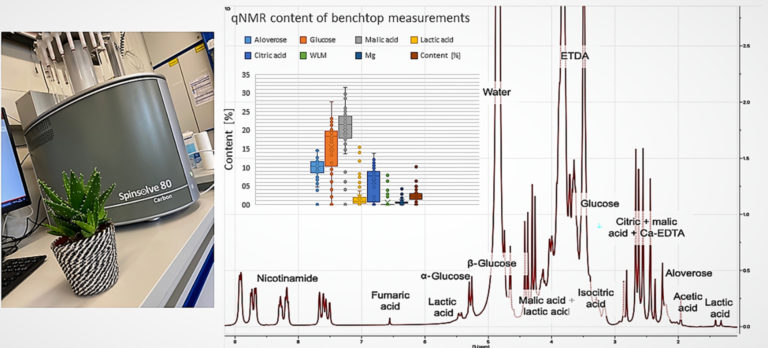393. What is the best spectroscopic method for simultaneous analysis of organic acids and (poly)saccharides in biological matrices: Example of Aloe vera extracts?
Franziska Block, Alexander May, Katharina Wetzel, Klaudia Adels, Gereon Elbers, Margit Schulze and Yulia Monakhova; Talanta Open (2023); DOI: 10.1016/j.talo.2023.100220 (open access)
Several species of (poly)saccharides and organic acids can be found often simultaneously in various biological matrices, e.g., fruits, plant materials, and biological fluids. The analysis of such matrices sometimes represents a challenging task. Using Aloe vera (A. vera) plant materials as an example, the performance of several spectroscopic methods (80 MHz benchtop NMR, NIR, ATR-FTIR and UV–vis) for the simultaneous analysis of quality parameters of this plant material was compared. The determined parameters include (poly)saccharides such as aloverose, fructose and glucose as well as organic acids (malic, lactic, citric, isocitric, acetic, fumaric, benzoic and sorbic acids). 500 MHz NMR and high-performance liquid chromatography (HPLC) were used as the reference methods.
UV–vis data can be used only for identification of added preservatives (benzoic and sorbic acids) and drying agent (maltodextrin) and semiquantitative analysis of malic acid. NIR and MIR spectroscopies combined with multivariate regression can deliver more informative overview of A. vera extracts being able to additionally quantify glucose, aloverose, citric, isocitric, malic, lactic acids and fructose. Low-field NMR measurements can be used for the quantification of aloverose, glucose, malic, lactic, acetic, and benzoic acids. The benchtop NMR method was successfully validated in terms of robustness, stability, precision, reproducibility and limit of detection (LOD) and quantification (LOQ), respectively.
All spectroscopic techniques are useful for the screening of (poly)saccharides and organic acids in plant extracts and should be applied according to its availability as well as information and confidence required for the specific analytical goal. Benchtop NMR spectroscopy seems to be the most feasible solution for quality control of A. vera products.
